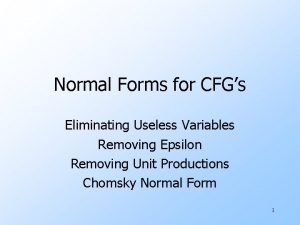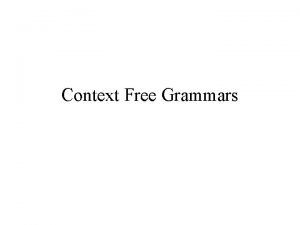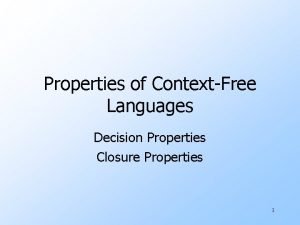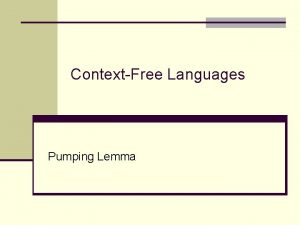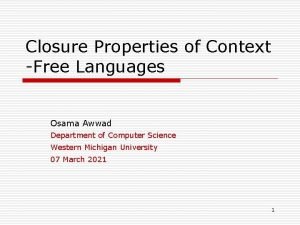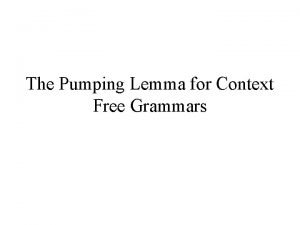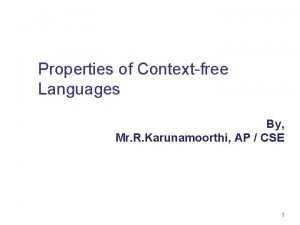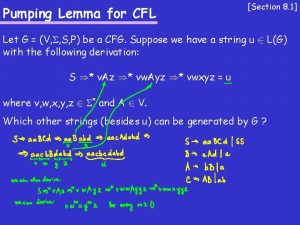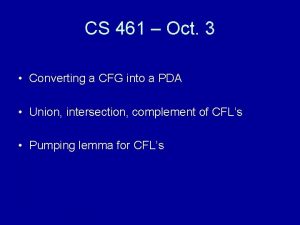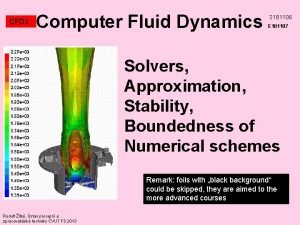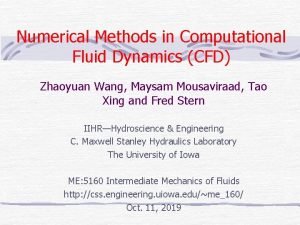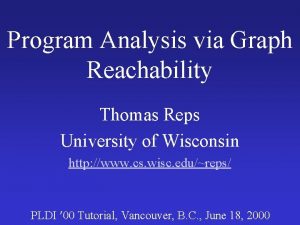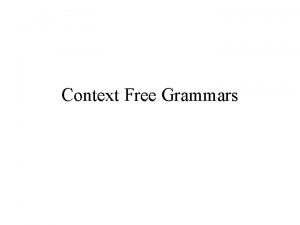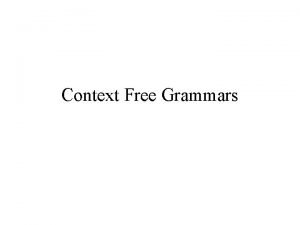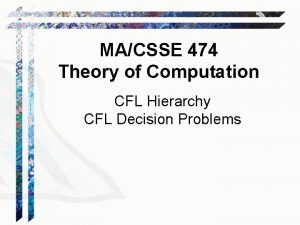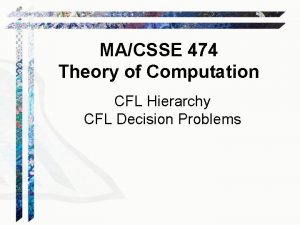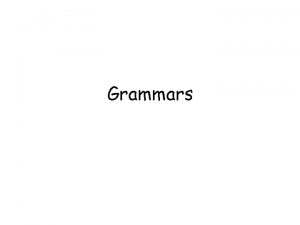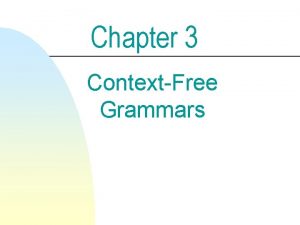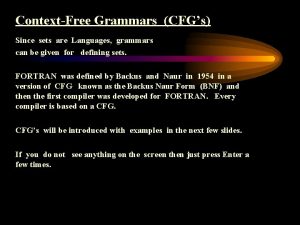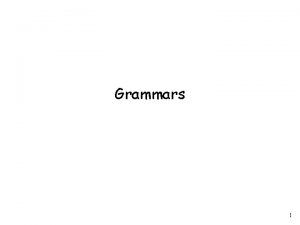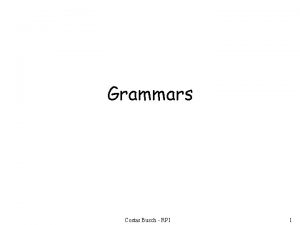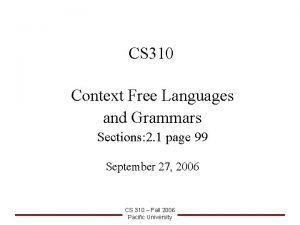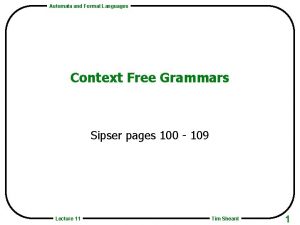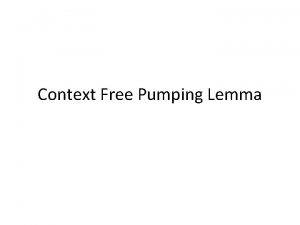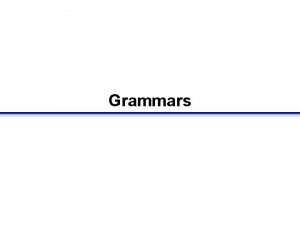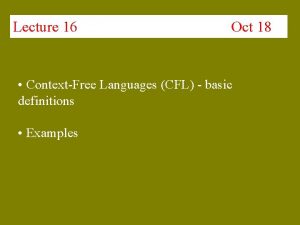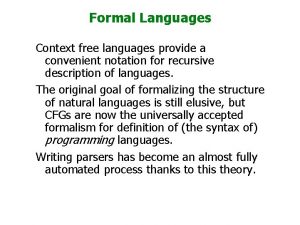Context Free Grammars Context Free Languages CFL The





























- Slides: 29

Context Free Grammars

Context Free Languages (CFL) • The pumping lemma showed there are languages that are not regular – There are many classes “larger” than that of regular languages – One of these classes are called “Context Free” languages • Described by Context-Free Grammars (CFG) – Why named context-free? – Property that we can substitute strings for variables regardless of context (implies context sensitive languages exist) • CFG’s are useful in many applications – Describing syntax of programming languages – Parsing – Structure of documents, e. g. XML • Analogy of the day: – DFA: Regular Expression as Pushdown Automata : CFG

CFG Example • Language of palindromes – We can easily show using the pumping lemma that the language L = { w | w = w. R } is not regular. – However, we can describe this language by the following context-free grammar over the alphabet {0, 1}: P P 0 P 1 Inductive definition P 0 P 0 P 1 P 1 More compactly: P | 0 | 1 | 0 P 0 | 1 P 1

Formal Definition of a CFG • There is a finite set of symbols that form the strings, i. e. there is a finite alphabet. The alphabet symbols are called terminals (think of a parse tree) There is a finite set of variables, sometimes called nonterminals or syntactic categories. Each variable represents a language (i. e. a set of strings). • – • • In the palindrome example, the only variable is P. One of the variables is the start symbol. Other variables may exist to help define the language. There is a finite set of productions or production rules that represent the recursive definition of the language. Each production is defined: 1. 2. 3. Has a single variable that is being defined to the left of the production Has the production symbol Has a string of zero or more terminals or variables, called the body of the production. To form strings we can substitute each variable’s production in for the body where it appears.

CFG Notation • A CFG G may then be represented by these four components, denoted G=(V, T, P, S) – V is the set of variables – T is the set of terminals – P is the set of productions – S is the start symbol.

Sample CFG 1. 2. 3. 4. 5. 6. 7. 8. 9. E I // Expression is an identifier E E+E // Add two expressions E E*E // Multiply two expressions E (E) // Add parenthesis I L // Identifier is a Letter I ID // Identifier + Digit I IL // Identifier + Letter D 0|1|2|3|4|5|6|7|8 |9 // Digits L a|b|c|…A|B|…Z // Letters Note Identifiers are regular; could describe as (letter)(letter + digit)*

Recursive Inference • The process of coming up with strings that satisfy individual productions and then concatenating them together according to more general rules is called recursive inference. • This is a bottom-up process • For example, parsing the identifier “r 5” – – Rule 8 tells us that D 5 Rule 9 tells us that L r Rule 5 tells us that I L so I r Apply recursive inference using rule 6 for I ID and get • I r. D. • Use D 5 to get I r 5. – Finally, we know from rule 1 that E I, so r 5 is also an expression.

Recursive Inference Exercise • Show the recursive inference for arriving at (x+int 1)*10 is an expression

Derivation • Similar to recursive inference, but top-down instead of bottom-up – Expand start symbol first and work way down in such a way that it matches the input string • For example, given a*(a+b 1) we can derive this by: – E E*E I*E L*E a*(E) a*(E+E) a*(I+E) a*(L+E) a*(a+I) a*(a+ID) a*(a+LD) a*(a+b 1) • Note that at each step of the productions we could have chosen any one of the variables to replace with a more specific rule.

Formal Description of Derivation • First we need some new terminology! • The process of deriving a string by applying a production from head to body is denoted by • If and are strings consisting of terminals and variables, and A is a variable, then let A be a production of grammar G. – We can then say A G – Often we will assume we are working with grammar G, and leave it off: A

Multiple Derivation Steps • Just as we defined ^, the extended transition function that accepts a string, we can also define a similar notion for the derivation • If we process multiple derivation steps, we use a * to indicate “zero or more steps” as follows inductively: – Basis: For any string of terminals and variables, we can say * . That is, any string derives itself. – Induction: If * and , then * . That is, if alpha can become beta in zero or more steps, then we can take one more step to gamma meaning alpha derives gamma. The proof is straightforward.

Multiple Derivation • We already saw an example of in deriving a*(a+b 1) • We could have used * to condense the derivation. – E. g. we could just go straight to E * E*(E+E) or even straight to the final step • E * a*(a+b 1) • Going straight to the end is not recommended on a homework or exam problem if you are supposed to show the derivation

Leftmost Derivation • In the previous example we used a derivation called a leftmost derivation. We can specifically denote a leftmost derivation using the subscript “lm”, as in: lm or *lm • A leftmost derivation is simply one in which we replace the leftmost variable in a production body by one of its production bodies first, and then work our way from left to right.

Rightmost Derivation • Not surprisingly, we also have a rightmost derivation which we can specifically denote via: • rm or *rm • A rightmost derivation is one in which we replace the rightmost variable by one of its production bodies first, and then work our way from right to left.

Rightmost Derivation Example • a*(a+b 1) was already shown previously using a leftmost derivation. • We can also come up with a rightmost derivation, but we must make replacements in different order: – E rm E*E rm E * (E) rm E*(E+I) rm E*(E+ID) rm E*(E+I 1) rm E*(E+L 1) rm E*(E+b 1) rm E*(I+b 1) rm E*(L+b 1) rm E*(a+b 1) rm I*(a+b 1) rm L*(a+b 1) rm a*(a+b 1)

Left or Right? • Does it matter which method you use? • Answer: No • Any derivation has an equivalent leftmost and rightmost derivation. That is, A * . iff A *lm and A *rm .

Language of a Context Free Grammar • The language that is represented by a CFG G(V, T, P, S) may be denoted by L(G), is a Context Free Language (CFL) and consists of terminal strings that have derivations from the start symbol: L(G) = { w in T | S *G w } • Note that the CFL L(G) consists solely of terminals from G.

Sentential Forms • A sentential form is a special name given to derivations from the start symbol. If we have a string that consists entirely of terminals or variables, then S * where S is the start symbol is a sentential form. • Note that we can have leftmost or rightmost sentential forms based on which type of derivation we are using.

CFG Exercises

Parse Trees • A parse tree is a top-down representation of a derivation – Good way to visualize the derivation process – Will also be useful for some proofs coming up! • If we can generate multiple parse trees then that means that there is ambiguity in the language – This is often undesirable, for example, in a programming language we would not like the computer to interpret a line of code in a way different than what the programmer intends. – But sometimes an unambiguous language is difficult or impossible to avoid.

Parse Tree Construction

Sample Parse Tree • Sample parse tree for the palindrome CFG for 1110111: P | 0 | 1 | 0 P 0 | 1 P 1

Sample Parse Tree • Using a leftmost derivation generates the parse tree for a*(a+b 1) • Does using a rightmost derivation produce a different tree? • The yield of the parse tree is the string that results when we concatenate the leaves from left to right (e. g. , doing a leftmost depth first search). – The yield is always a string that is derived from the root and is guaranteed to be a string in the language L.

Inference, Derivations, and Parse Trees • We have used the following forms to describe the processing of CFG’s to describe whether or not a string s is in the language given a CFG with start symbol A: 1. 2. 3. 4. 5. • The recursive inference procedure run on s can determine that s is in the language A * s A *lm s A *rm s The parse tree rooted at A contains s as its yield All of these forms are equivalent for strings consisting of terminal symbols. All of these forms except for #1 are equivalent for strings consisting of terminals or variables (this is because we only defined recursive inference for terminal symbols). • – However, derivations and parse trees are equivalent even including variables. This means that if we can create a parse tree of some sort, we can create a corresponding derivation, either leftmost, rightmost, or mixed, that expresses the same behavior as the parse tree.

Proof of Equivalence between Derivation, Recursive Inference, Parse Trees • Skipping equivalences; proven in text. General strategy: Recursive Inferences Parse Tree (Left | Right derivation) derivation Recursive Inference • The loop back to recursive inferences completes the equivalence. – To go from recursive inferences to parse trees, we create a child/parent relationship each time we make a recursive inference. – The parse tree can generate a leftmost derivation by following leftmost children in the tree first, while the rightmost derivation examines rightmost children in the tree first. – A derivation to recursive inference is done by showing that individual productions of the form A w can be built into A *w.

Ambiguous Grammars • A CFG is ambiguous if one or more terminal strings have multiple leftmost derivations from the start symbol. E E – Equivalently: multiple rightmost derivations, or multiple parse trees. + E E * E + E • Examples E – E E+E | E*E – E+E*E can be parsed as • E E+E*E • E E*E E+E*E E

Ambiguous Grammar • Is the following grammar ambiguous? – S AS | ε – A A 1 | 01 – Try for 00111 • S AS A 1 S 0 A 11 S 00111ε • S AS 0 A 11 S 00111ε

Removing Ambiguity • No algorithm can tell us if an arbitrary CFG is ambiguous in the first place – Halting / Post Correspondence Problem • Why care? – Ambiguity can be a problem in things like programming languages where we want agreement between the programmer and compiler over what happens • Solutions – Apply precedence – e. g. Instead of: E E+E | E*E – Use: E T | E + T, T F | T * F • This rule says we apply + rule before the * rule (which means we multiply first before adding)

Inherent Ambiguity • A CFL is said to be inherently ambiguous if all its grammars are ambiguous – Obviously these would be bad choices for programming languages – Such things exist, see book for some details
 Handling questions in context-free grammars
Handling questions in context-free grammars Eliminating epsilon productions from cfg
Eliminating epsilon productions from cfg Regular grammars generate regular languages
Regular grammars generate regular languages A grammar g=(v.t.p.s) in which v represents
A grammar g=(v.t.p.s) in which v represents Decision properties of context free languages
Decision properties of context free languages Pumping lemma for context free languages
Pumping lemma for context free languages Decision properties of context free languages
Decision properties of context free languages Closure properties of cfg
Closure properties of cfg Context free grammar pumping lemma
Context free grammar pumping lemma Decision properties of context free languages
Decision properties of context free languages Unrestricted grammar example
Unrestricted grammar example Types of grammar
Types of grammar Cfl closed under reversal
Cfl closed under reversal Pumping lemma for cfl examples
Pumping lemma for cfl examples Cfl to cfg conversion
Cfl to cfg conversion Explicit method is stable only if
Explicit method is stable only if What is cfl number in cfd
What is cfl number in cfd Cfl reachability
Cfl reachability Pumping lemma for cfl
Pumping lemma for cfl What does cfl stand for
What does cfl stand for Communicating across generational differences
Communicating across generational differences Example of presupposition
Example of presupposition Soal essay komunikasi nonverbal
Soal essay komunikasi nonverbal High context vs low context culture ppt
High context vs low context culture ppt Dạng đột biến một nhiễm là
Dạng đột biến một nhiễm là Vẽ hình chiếu đứng bằng cạnh của vật thể
Vẽ hình chiếu đứng bằng cạnh của vật thể độ dài liên kết
độ dài liên kết Các môn thể thao bắt đầu bằng tiếng nhảy
Các môn thể thao bắt đầu bằng tiếng nhảy Voi kéo gỗ như thế nào
Voi kéo gỗ như thế nào Thiếu nhi thế giới liên hoan
Thiếu nhi thế giới liên hoan

